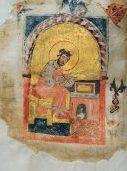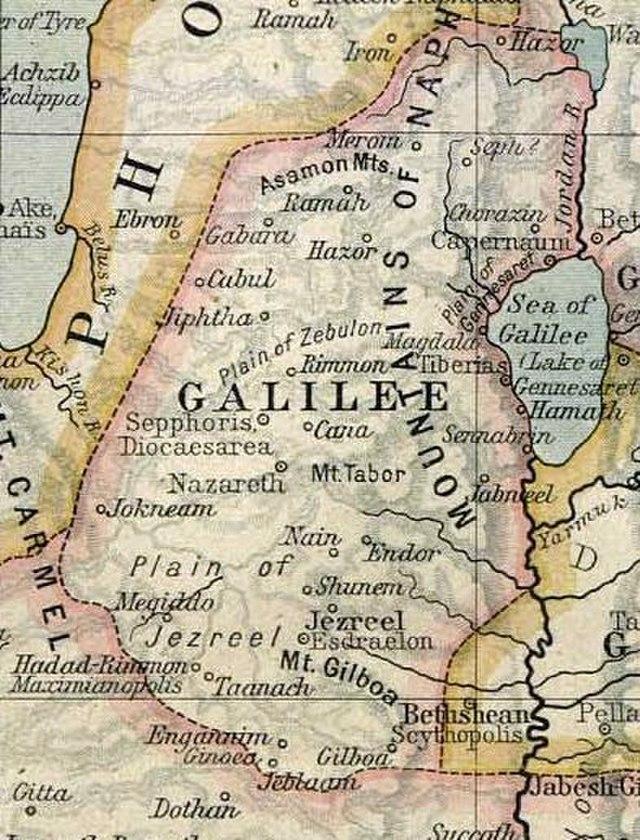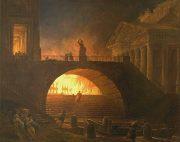Mark and the other Gospels

The Gospel according to Mark is one of the three ‘synoptic’ gospels, called this as they ‘see with one eye’ the life of Jesus of Nazareth. Mark is believed by most scholars to be the earliest compilation of the good news (gospel) of Jesus, with both Matthew and Luke, the other two synoptics, following his general outline. Mark’s gospel was probably written around 70 CE, placing its writing at about the time of the destruction of the Temple in Jerusalem.
According to early tradition the gospel was written by Mark, a disciple of Peter. This is now debated. However, that it is sourced from an oral collection of sayings and stories about Jesus that originated with Peter and circulated in the local community is generally uncontested. Owing to its association with Peter, that it interprets the Aramaic phrases it uses (5:41, 7:34, 15:34) and that it contains explanations of Jewish customs (for example 7:3-4) the community Mark knows and writers for are thought to be Gentiles, living in Rome.
The structure of Mark’s writing:
Mark’s gospel is a deliberate piece of work intended to persuade the community he knows of the transformative power of faith in Jesus. Mark crafts his gospel carefully. Scholars recognise at least two structural frameworks.
a) A geographical frame

Mark’s gospel introduces us to Jesus, a Jew from Galilee, whose story is mostly set in the Galilean countryside. Jesus makes one journey to Jerusalem, where he is crucified by order of the Roman military authorities, and from where he rises from the dead after three days. This storyline provides a simple geographical frame for Mark’s Gospel: Jesus spends his early days in the north (Mk 1:1- 9:50), travels to Jerusalem (Mk 10:1 – 11:1) and is tried, crucified, dies and rises (Mk 11:2 – 16:8). Scholars consider that Mk 16:8 is the end of Mark’s own writing, although a longer ending has been added at a later date in some manuscripts.
b) Narrative frame
A second framework sees the work as a narrative of two halves. The first half of the gospel (Mk 1:1-8:30) introduces Jesus and orients the reader/listener to the places and people who will figure in the writing, and revolve around the question ‘Who is Jesus, the Christ?’ This half can be further subdivided into the following sections:
1:1-13 Prologue
The prologue lays our Mark’s beliefs from the start: this is ‘the beginning of the good news of ‘Jesus Christ, the Son of God’ (Mk 1:1). The gospel then opens with John the Baptist inviting people to prepare the way of the Lord (Mk 1:3), through a baptism ‘of repentance for the forgiveness of sins (Mk 1: 4).
1:14-8:30 The Galilean ministry
With his identity confirmed through God’s own words at his baptism, Jesus’ himself proclaims his intention and the thrust of his life-work: ‘… the kingdom of God has drawn near. Repent and believe in the gospel’ (Mk 1:15).
His mission announced, Mark then describes how Jesus interacts with various individuals, healing, teaching and forgiving as he comes into conflict with religious leaders who ’question in their hearts’ (Mk 2:6), conspire his downfall (Mk 3: 6) and eventually actively argue with him (Mk 8:11). The question of this half, ‘Who is this man?’ will be answered when Peter responds on behalf of the disciples, ‘You are the Messiah’ (Mk 8:30).
In the second half of the gospel (Mk 8:31-16:8), Mark shows Jesus teaching his disciples that although they know him as messiah, he will not be the messiah they were expecting. Rather, he will be a suffering Messiah, the ‘Son of Man’: rejected by both religious and civil leaders and put to death as a criminal only to rise again after three days. Further, Jesus will explain that, if they wish to be his followers, as disciples, they too must take up their cross and follow him (Mk 8:34). Indeed, for Mark, understanding of the life of Jesus centres on and leads up to, the cross.
Within this second half we find smaller sub-divisions.
| 11:1-13:37 | The Jerusalem ministry |
| 14:1-16:8 | Passion and Resurrection |
| 16:9-19 | Epilogue |
Mark’s portrait of Jesus:
Mark’s whole gospel is centred on unfolding the mystery of who Jesus is. In Mark’s eyes we meet a messiah who heals the sick and preaches with authority, forgives sins as only God can do, and interprets God’s Law, the very same Law given to Moses. For Mark, Jesus welcomes outcasts, offers forgiveness to sinners and casts unclean spirits out of tormented sufferers. Jesus silences the wind and the storm, and, all the time, living, teaching and modelling, that the kingship of God has entered the world in a new way in acts of service and selfless giving.
However, Mark’s Jesus is fragile. He finds himself confused and at times he is unsure of what is happening. He lacks a sense of peace that Luke will give him and the divine confidence John will give him. His time in Gethsemane will be torment; he will die alone, believing himself abandoned and forsaken by the God he has sought to reveal (Mk 15:34).
Mark’s portrait of the disciples:
Mark’s gospel is recognised for its teaching on discipleship. Within 16 verses of the opening of the Gospel, Mark tells us that Jesus has called people to come and follow. Following will be the hallmark of those, men and women, who are invited to join Jesus and take on his vision and ministry as their own.
By the middle of the gospel, however, the group of disciples Mark calls ‘the twelve’ will fail three times to understand Jesus’ predictions of his suffering (8:27-10:34), they will argue about which one of them will hold position of honour in the new kingdom (Mk 10:36), let him down in Gethsemane (Mk 14: 32ff), and eventually they will desert him and flee (Mk 14:50). Three times Peter will deny any knowledge of Jesus (14:54-72), just as Jesus is acknowledging his own divine status before the high priest. While they respond enthusiastically at first, the twelve will be rebuked by Jesus for their lack of understanding (4:40, 8:17-18) and for their failure to realise that greatness means taking on the role of a servant (Mk 9:33).
Not all the disciples fail Jesus, however. Outside the twelve, Peter’s mother in law serves (Mk 1:31), the centurion recognises Jesus as the son of God (Mk 15:39) and Levi answers the call to follow (Mk 2:13-15). Two women are particularly noted for their understanding. In Mark 12:41-44 Jesus commends the poor widow, affirming her selfless giving; in Mk 14:3-9 he declares that the actions of the un-named woman who anoints his head will be ‘told in remembrance of her (Mk 14:9). Others who encounter Jesus in his ministry also come across in a positive light: the Syrophoenician woman in 7:26-30 who challenges Jesus to a more open ministry and the blind man at Jericho (Mk 10:46-52) who serves to model the power of personal faith.
Mark’s community; the people he writes for:
As we read or listen to Mark’s gospel we must remember that it was not written for us. Neither was it written for the people or world it writes about. Standing between the life of Jesus and our reading of it, are a community caught in the midst of persecution. To really understand the Gospel of Mark we must read it carefully, respecting its own integrity and authenticity. Details found in the other gospels (and there will be many as the other gospels are longer) need to be left aside so we can listen as Mark’s own community did, mindful of their experiences, their questions and their fears.

The suffering and death of Jesus was an inspiration to his followers, but it was also a problem. Mark records that the first disciples were so determined to follow Jesus that they left their lives ‘immediately’ (Mk 1:17). However, in contrast to the disciples in Jesus’ lifetime, Mark’s own community had much more to consider. Discipleship; ‘following’ and acting upon belief in Jesus as the messiah, placed Mark’s community at odds with the Roman Emperor Nero.
Nero’s hatred of the early Christian movement is well attested to: blaming them for the fire that destroyed much of Rome in 64 CE, he had Peter and Paul killed, while be-heading and burning alive hundreds more. Some he had torn to death by dogs. Whether the reason Nero hated Christians was based solely on his view that they had set fire to Rome is unclear; some scholars suggest that a refusal to worship his own proclaimed divinity was at the heart of the dispute. Either way key among the questions asked of Mark was: if discipleship could cost you your life, was it worth the risk?
Can Mark’s writing be relevant to us, now?
Mark’s account of the inner circle of disciples who fail Jesus invites us to consider our own energetic responses to faith which come to little. We are all prone to start well, and fade when difficulties emerge. Is Mark aiming to encourage the frail disciples in his own community? Can his words still inspire a frail community now?
Mark notes positively a number of people, who are, by their actions, disciples of Jesus. These, often un-named people, challenge a narrow vision of who the disciples of Jesus were. More often than not, they are neither recognised nor taught as the disciples of Jesus. Their presence in recognising Jesus as the Christ amid the publicity of the twelve compels us to consider our own view of discipleship, lest their example is lost. How can we reflect Mark’s message more fully, so that what they have done might finally be told, ‘in remembrance of them?’
Mark’s gospel proclaimed that Jesus’ suffering was overcome in the glory of the resurrection. His words, in the silence of the women who say nothing on finding the empty tomb, whispered that Jesus’ later followers might also find joy in God’s kingdom. Is the way of the cross still the only path to glory? Does Mark’s writing continue to remind us that there is no easy way in a hostile culture for true followers of Jesus?
The Gospel of Mark tells us that Jesus was God’s Son who contradicted all expectations of a messiah by his suffering and death, which, for Mark and the other evangelists, redeemed humanity, albeit in a different way (Mk 10:45). Mark’s community were challenged to consider their fate as Christians living in a hostile Rome. How might the challenges they faced speak to us differently, now? If the messiah would be faithful in the face of death can we stand faithfully in a sometimes unfriendly world?
